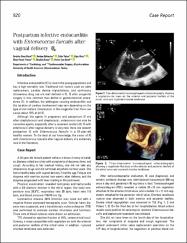| dc.contributor.author | Dural, İbrahim Etem | |
| dc.contributor.author | Gökaslan, Serkan | |
| dc.contributor.author | Yalım, Zafer | |
| dc.contributor.author | Aksu, Uğur | |
| dc.contributor.author | Yılmaz, Ömer Faruk | |
| dc.contributor.author | Ersoy, İbrahim | |
| dc.contributor.author | Sevil, Fehim Can | |
| dc.date.accessioned | 2022-05-11T05:58:57Z | |
| dc.date.available | 2022-05-11T05:58:57Z | |
| dc.date.issued | 2021 | en_US |
| dc.identifier.citation | Dural, İ. E., Gökaslan, S., Yalım, Z., Aksu, U., Yılmaz, Ö. F., Ersoy, İ., & Sevil, F. C. (2021). Postpartum infective endocarditis with Enterococcus faecalis after vaginal delivery. Anatolian Journal of Cardiology, 25(12), 920. | en_US |
| dc.identifier.issn | 2149-2263 | |
| dc.identifier.issn | 2149-2271 | |
| dc.identifier.uri | https://doi.org/10.5152/AnatolJCardiol.2021.29797 | |
| dc.identifier.uri | https://hdl.handle.net/20.500.12933/970 | |
| dc.description.abstract | Infective endocarditis (IE) is rare in the young population and
has a high mortality rate. Traditional risk factors such as valve
replacement, cardiac device implantations, and continuous
intravenous drug use are well defined in IE. IE after urogenital
surgery is less common than dental or gastrointestinal procedures (1). In addition, the pathogens causing endocarditis and
the location of cardiac involvement may vary depending on the
type of risk factors. Enterococci in the urogenital tract flora can
cause about 10% of all IE.
Although the agents in pregnancy and postpartum IE are
often staphylococci and streptococci, enterococci can also be
causative agents, especially after a cesarean section (2). IE with
enterococci after vaginal delivery is very rare. Here, we present
postpartum IE with Enterococcus faecalis in a 24-year-old
healthy woman. To the best of our knowledge, the cases of IE
with Enterococcus faecalis after vaginal delivery are extremely
rare in the literature. | en_US |
| dc.language.iso | en | |
| dc.publisher | AVES Yayıncılık | en_US |
| dc.relation.ispartof | The Anatolian Journal of Cardiology | |
| dc.rights | info:eu-repo/semantics/openAccess | en_US |
| dc.title | Postpartum infective endocarditis with Enterococcus faecalis after vaginal delivery | en_US |
| dc.type | Article | |
| dc.identifier.orcid | 0000-0003-4005-4858 | en_US |
| dc.identifier.orcid | 0000-0001-7268-178X | en_US |
| dc.identifier.orcid | 0000-0001-7736-0205 | en_US |
| dc.identifier.orcid | 0000-0003-0918-5032 | en_US |
| dc.identifier.orcid | 0000-0002-0055-8341 | en_US |
| dc.identifier.orcid | 0000-0002-9553-8801 | en_US |
| dc.identifier.orcid | 0000-0003-3902-9831 | en_US |
| dc.department | AFSÜ, Tıp Fakültesi, Dahili Tıp Bilimleri Bölümü, Kardiyoloji Ana Bilim Dalı | en_US |
| dc.institutionauthor | Dural, İbrahim Etem | |
| dc.institutionauthor | Gökaslan, Serkan | |
| dc.institutionauthor | Yalım, Zafer | |
| dc.institutionauthor | Aksu, Uğur | |
| dc.institutionauthor | Yılmaz, Ömer Faruk | |
| dc.institutionauthor | Ersoy, İbrahim | |
| dc.institutionauthor | Sevil, Fehim Can | |
| dc.identifier.doi | 10.5152/AnatolJCardiol.2021.29797 | |
| dc.identifier.volume | 25 | en_US |
| dc.identifier.issue | 12 | en_US |
| dc.identifier.startpage | 920 | en_US |
| dc.identifier.endpage | 921 | en_US |
| dc.relation.publicationcategory | Makale - Ulusal Hakemli Dergi - Kurum Öğretim Elemanı | en_US |
| dc.identifier.pmid | 34866587 | |
| dc.identifier.scopus | 2-s2.0-85122460824 | |
| dc.identifier.scopusquality | Q3 | |
| dc.identifier.trdizinid | 487424 | |
| dc.identifier.wos | WOS:000727754800011 | |
| dc.identifier.wosquality | Q4 | |
| dc.indekslendigikaynak | Web of Science | |
| dc.indekslendigikaynak | Scopus | |
| dc.indekslendigikaynak | TR-Dizin | |
| dc.indekslendigikaynak | PubMed | |
















